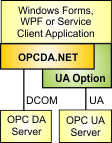 |
OPCDA.NET-UA
OPC UA Option for the OPCDA.NET Client Component. |
The OPCDA.NET-UA component extends the OPCDA.NET Client Component with an OPC UA (Unified Architecture) wrapper. The application can access OPC DA and UA servers through the same API.
|
OPCDA.NET based client applications become OPC UA clients without having to be modified. The applications only need to be compiled with a reference to the OPCDA.NET component with the UA option.
Depending on the server ID (url), the server is either accessed as an OPC DA DCOM server or an OPC UA server.
For UA server access DCOM is completely eliminated because the UA handling is within the client process. There is no external DCOM to UA proxy server involved. The client application acts as a native OPC UA client.
Without additional application development effort the application can access DCOM OPC DA server and OPC UA servers.
|
|
 |
OPCDA.NET-UA Advantages
- The OPCDA.NET-UA component enhances existing OPCDA.NET based OPC DA client applications with the capability to access OPC UA servers.
No code changes are required in the OPC DA application. Only the OPCDA.NET assembly references need to be changed to the assembly version with UA support and the OpcDaNetUaOption.dll needs to be additionally referenced.
- New client applications can be developed to support access to the widely installed classic OPC DA servers as well as OPC UA servers.
For UA server access DCOM usage is completely eliminated, unlike solutions with an external UA proxy server.
With the client application able to access OPC DA and OPC UA servers there is no need for external converters. This simplifies the installation, the configuration and the maintenance of the application. No converter (UA proxy) module needs to be installed, configured and maintained. There is one less component that may fail.
Top performance is achieved. The application communicates directly with the server. For OPC DA server access there is an efficient .NET wrapper that handles the DCOM interface. For UA server access the .NET code performs the WCF based UA communication through the OPC UA communication stack.
OPCDA.NET-UA Limitations
The UA server access is limited to the Data Access (DA) profile of the UA server. The Historian (HDA) and Alarm&Event (AE) features of the UA server cannot be accessed through the OPC DA client interface.
If also HDA fuctionality is required then the OPCHDA.NET / OPCHDA.NET-UA products need to be used in combination with OPCDA.NET /OPCDA.NET-UA.
If also A&E fuctionality is required then the OPCAE.NET / OPCAE.NET-UA products need to be used in combination with OPCDA.NET /OPCDA.NET-UA.
OPC UA specific Features
The application can use OPC UA specific features by directly using the OPCDA.NET-UA classes.
Such features are:
- Endpoint discovery and endpoint selection
- UA methods discovery and calls
OPCDA.NET-UA Feature Summary
- .Net applications can access OPC DA and OPC UA servers through the same API
- All OPCDA.NET classes can access DA and UA servers.
- The server type is determined by the server name (ProgID or URL).
- The UA configuration is defined in an additional configuration XML file.
- UA specific configuration and testing tools are provided.
- Detailed UA errors can be logged to file or the application can define a callback method for UA error/trace information.
- High performance for DA and UA server access.
- Pure .NET code that runs in 32-bit or 64-bit for DA and UA server access.
- UA Methods handling
Requirements
- OPCDA.NET Professional Edition V11.0 or newer
- Windows 7, 8.x, 10 or Windows Server 2008, 2012, 2016 32 or 64bit
- .NET 4.x
- Visual Studio 2010,2012,2013,2015 or 2017
| 